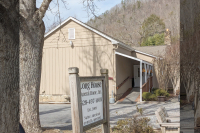Heliker & Lahotan Foundation’s WNC connection keeps the creative vision alive
By Sarah Kucharski • Staff Writer
Gaily colored petals of long-stemmed Cosmos flowers lilt along on the sea-swept winds that blow across Great Cranberry Island, located just off the coast of Maine where Patricia Bailey, an associate professor of art at Western Carolina University, is at work directing another season of artist residencies.
The sun sets against a low tree line, casting a warm pink light across the tidal basin and filling artists’ studios with the glow of evening. This is when painter and printmaker Joseph Norman comes alive. The self-proclaimed night owl created 30 works in the first week of his residency at the Heliker-LaHotan Foundation. Norman, former chair of painting and drawing and professor at the Lamar Dodd School of Art at the University of Georgia, characterizes his works as expressive poetic realism spanning across several media.
“I hope to have a chance to reconnect with my creative spirit during this residency,” Norman said. “For me, this is a transitional period in my personal life and I have to retool before making the next move. I want to learn to work again in silence and become comfortable once again with being alone with my thoughts.”
Under a rising moon, Norman toils energetically in his temporary studio that houses a press and other equipment from the studio of the late artist Charles Wadsworth, a friend of the two artists whose home the foundation now operates as an artists’ sanctuary.
Formed in 1993, the foundation is dedicated to the artistic vision of the two painters, John Heliker and Robert LaHotan, who were its founders. Heliker had a long career in the New York art world. He taught at Columbia University, founded the New York Studio School and taught the master of fine arts painting program at Parsons School of Design. Winner of the Prix de Rome and a Guggenheim Fellowship, he showed widely and was the subject of the first retrospective exhibition in the Whitney Museum of American Art’s new building in 1968.
A Fulbright Scholar who earned his master of fine arts from Columbia University, LaHotan drew artistic inspiration from the landscape and contemporary impressionist painters including Matisse and Bonnard. He taught art at the Dalton School in New York for more than 30 years. In New York City and in Maine, the foundation is engaged in a variety of projects that perpetuate the painters’ legacy, including a residency program on Great Cranberry Island for painters and sculptors of established ability.
WCU’s Bailey met Heliker and LaHotan while living in New York. She earned her master of fine arts degree from the Pratt Institute in 1971, worked at the Metropolitan Museum of Art and taught at Parsons School of Design before coming to WCU in 2001.
Her long friendship with the artists led her to accept a leadership role on the Heliker-LaHotan Foundation’s board of trustees. When Heliker died in 2000, LaHotan charged the foundation’s board with forming a residency program that would celebrate Great Cranberry’s artist community, which included Ashley Bryan, Dorothy Eisner and Charles Wadsworth. With LaHotan’s death in 2002, Bailey worked diligently to open the Heliker-LaHotan home and studios to artists.
At home with Heliker & Lahotan
The landscape of Great Cranberry Island and community of artists there bade Heliker and LaHotan to purchase a 19th-century house and boatyards built by Capt. Enoch B. Stanley on a sheltered tidal pool that had once been the prosperous and busy harbor door to the island during clipper-ship days. The island was sparsely populated, with most residents working on farms or at sea; however, it was known as a shipbuilding center.
Great Cranberry is the largest of a group of five islands to the southeast of Bangor in the Gulf of Maine, near the entrance to Somes Sound and the two harbors that sit to either side of its mouth. Both Great and Little Cranberry islands, which got their names from the wild low-bush cranberries that grow there in the fall, still have small year-round populations of lobstermen and boat builders.
Heliker and LaHotan spent the most productive years of their lives painting on Cranberry in the summers and teaching and painting in New York during the winters. Their historic home has been left very much as it was while Heliker and LaHotan lived there. Artists each have private bedrooms and use of the living quarters. Three large bookcases offer a wealth of reading, and in the eat-in kitchen black-and-white tiled countertops stretch under a row of hanging skillets. Hardwood floors are found throughout and wide windowsills make an excellent perch for Bailey’s cats. A modest garden supplies some of the produce for residents’ meals, and mainland grocery stores deliver other supplies by ferry. The home-like feel is part of what makes the residency so welcoming to artists who may recognize the surrounding scenery in the work of their brethren - one of Walker Evans’ most famous photographs is of the home’s cast-iron parlor stove.
“The most inspiring aspect of my visit has been the connection to Heliker and LaHotan,” said Ruth Bernard, a neo-expressionist painter and adjunct professor of art at Penn State-Berks. “I feel I am an extension of them by continuing the tradition of the creative process begun by Heliker and LaHotan and others of their generation.”
The foundation welcomed its first four residents in 2006. In 2007, there were eight artists; 11 in 2008. This year the residency program will bring 15 for the three- to four-week residencies that are designed for artists of established ability. The group hails from locations stretching from Kaleva, Mich., to Memphis, Tenn., and Athens, Ga., to Audierne, France.
Residents must bring with them whatever materials they will need, as there is no source of art supplies on the island, and few on the mainland. It is recommended that such items be shipped ahead of time. The island’s ferries are more than a novelty, they are a way of life. There is a small post office, a general store, a community center, an exercise facility, and a single church with non-denominational services held only in the months of July and August.
The summer is when the island population swells to hundreds of part-time residents and summer vacationers; however, artists much embrace their seclusion. No more than three artists are in residence at a time. The island studios offer a wealth of natural light, views of the tidal basin and solitude on the private shore, which is what Heliker and LaHotan wanted.
“This place is so supportive of uninterrupted work,” Bailey said.
The Great Cranberry experience translates to a sense of intimacy within one’s works, said Susan Danly, curator of graphics, photography and contemporary art at the Portland Museum of Art, which recently hosted “Art of the Cranberry Isles.” The exhibit features 25 pieces from artists working on the Cranberry Islands throughout the 1950s, ’60s and ’70s.
John David Wissler, a painter from Pennsylvania, studied under Heliker at the Parson School of Design and saw the landscape and its spirit in Heliker’s works. He has made a special connection to the Heliker-LaHotan home during his residency.
“The place will be with me and in my work for quite some time,” Wissler said. “I knew it would be a place I would want to paint. It has been wonderful.”
Fostering the arts
With funding from a recently awarded stipend, Bailey this year will help further develop the residency program and support two exhibitions on Heliker’s work. One exhibition is being collected from Heliker’s drawings and associated materials from his time working on the Works Progress Administration Federal Art Project, the first major attempt at government patronage of the visual arts in the United States and the most extensive and influential of the visual arts projects conceived during the Depression.
Heliker’s work is among the more than 100,000 easel paintings created during the project’s eight-year existence. David Lewis, associate professor of art history at Stephen F. Austin State University in Texas, is developing the exhibit with research assistance from Tara Jones, a graduate of Western Carolina. The two have been going through the foundation’s extensive archives of Heliker’s work and pulling materials such as sketchbooks and letters that no one has seen since Heliker created them. Jones also is serving as the Heliker-LaHotan facility coordinator and Bailey’s assistant.
The artist’s connection
The foundation’s reach spread to Western Carolina’s Fine Art Museum, which is home to a donated 1989 Heliker painting titled “The Visit II.” The work was hung in 2005 during an inaugural exhibition “Worldviews: Selections from the Permanent Collection.” The work helps anchor the focus of the collection, and will greatly strengthen the museum’s teaching mission, said Martin DeWitt, founding director of WCU’s Fine Art Museum.
“As we examine the beautiful work of Mr. Heliker, we can discuss his early roots as a modernist, and trace his extraordinary journey as artist and teacher, the influence of which continues to this day,” DeWitt said.
The Fine Art Museum may in coming years become host to Lewis’ exhibit of Heliker’s WPA works. DeWitt has a special connection to the Heliker-LaHotan Foundation. Both his brothers, each of whom is a painter, will have completed residencies on Great Cranberry Island this year. The cultural round-robin also has meant that artists such as painter and printmaker Norman have appeared as visiting artists at WCU, and through this connection learned about the Heliker-LaHotan Foundation and are in turn exploring their creativity during a residency.
The artists’ vibrancy is contagious, Bailey said, and dinnertime conversations welcome lively discussion about academia, teaching methods and, of course, art. After time spent on the island, Bailey, who teaches drawing and painting, comes back to her campus classroom with a renewed sense of purpose.
“I’m energized,” Bailey said. “I’m energized by the artists I have the privilege of working with.”
For more information about the Heliker-LaHotan Foundation, visit www.heliker-lahotan.org/. Former WCU new media professor Katya Moorman designed the site, which is maintained by WCU alumnus Andrew Kinnear.





